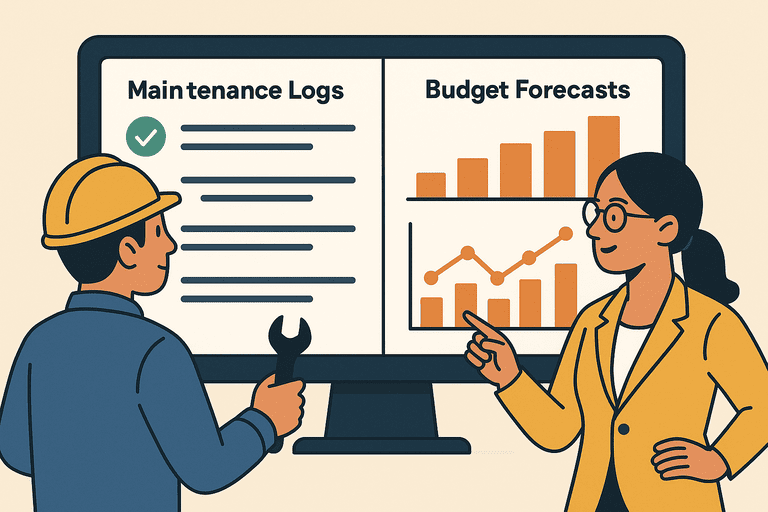Linking Asset Maintenance Data to Accounting and Budget Forecasting
Learn how linking asset maintenance data with accounting systems improves forecasting, reduces costs, and supports smarter decisions.

Introduction
Maintenance isn’t just about keeping assets working — it’s about protecting your company’s investments.
Yet, in many organizations, maintenance data and accounting data live in separate silos.
When these two worlds connect, businesses gain powerful insights:
- When to repair vs. replace
- How maintenance impacts depreciation
- How to forecast capital expenditures accurately
This article explains how integrating asset maintenance tracking with accounting and budgeting systems helps teams save money, plan smarter, and stay compliant.
1. The Hidden Cost of Disconnected Data
If maintenance and accounting run on separate systems, you risk:
- Unplanned downtime from missed service schedules
- Duplicate expenses when items are replaced too soon
- Poor forecasting because real asset conditions aren’t visible
- Compliance gaps when maintenance logs don’t match depreciation records
Disconnected data hides true performance.
You can’t make financial decisions on incomplete information.
2. Why Linking Maintenance Data to Accounting Matters
When both systems talk to each other, you can:
- See total cost of ownership (TCO) — not just purchase price
- Improve budget accuracy by factoring in real maintenance history
- Track asset value decline based on usage and condition
- Ensure audit-ready records with maintenance evidence
The result: every repair, inspection, or part replacement has a measurable financial story behind it.
3. How to Connect Maintenance with Accounting Systems
Step 1. Use a Unified Asset Database
Start with a central source of truth — every asset has:
- A unique ID (QR, barcode, or tag)
- Maintenance history
- Purchase and depreciation details
This foundation lets both maintenance and finance teams speak the same “asset language.”
Step 2. Automate Data Flow Between Systems
Use integrations or scheduled exports to connect:
- Maintenance systems → Accounting software (e.g., Xero, QuickBooks, Sage)
- Share cost updates, repair dates, and depreciation triggers
Example:
When a laptop gets a costly repair, the event triggers an update in accounting — adjusting its remaining book value automatically.
Step 3. Link Budgets to Real Maintenance Trends
Once integrated, your finance team can:
- Identify assets with rising maintenance costs
- Predict when replacements will be needed
- Plan CAPEX vs OPEX spending more accurately
This turns maintenance logs into forecasting gold.
4. KPIs That Improve with Integration
| KPI | Before | After |
|---|---|---|
| Maintenance cost tracking | Manual, inconsistent | Automated, categorized |
| Depreciation accuracy | Based on schedule | Based on condition |
| Budget forecasting | Reactive | Predictive |
| Audit readiness | Slow, error-prone | Instant, traceable |
Integrating data turns maintenance logs into strategic intelligence — not just paperwork.
5. Implementation Checklist
✅ Centralize all asset records (maintenance + financial)
✅ Assign unique IDs to each asset
✅ Choose compatible integrations (e.g., QuickBooks API, CSV sync)
✅ Set rules for repair thresholds and replacement alerts
✅ Generate monthly joint reports for management
Small improvements in data flow can lead to massive savings at scale.
Conclusion
Linking maintenance data to accounting bridges the gap between technical upkeep and financial performance.
It empowers organizations to:
- Reduce unplanned costs
- Predict capital needs
- Make repair vs. replace decisions with confidence
When your maintenance system talks to your accounting software, every wrench turn tells a financial story.
👉 Connect your maintenance data with your finances today.
Start with InvyMate — the smart asset platform built to integrate maintenance, tracking, and budgeting into one seamless workflow.